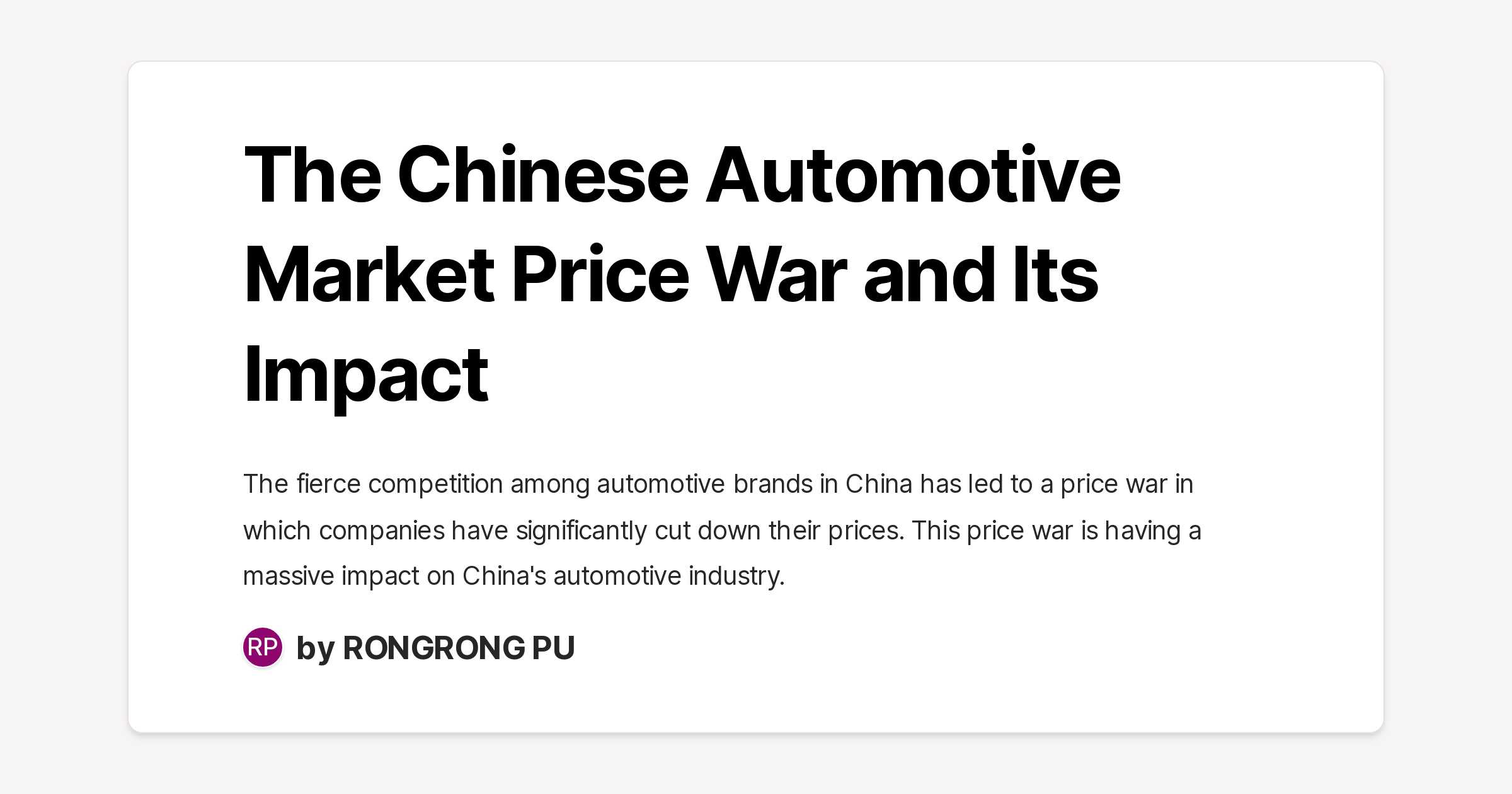Analyzing The Chinese Automotive Market: The Case Of BMW And Porsche

Table of Contents
BMW's Strategy in the Chinese Automotive Market
Localization and Customization
BMW's success in China hinges on its dedication to tailoring its offerings to the unique preferences of Chinese consumers. This strategy encompasses various aspects:
- Localized Models and Features: BMW offers models specifically designed with Chinese consumer preferences in mind, including features like extended wheelbases for increased rear passenger space and unique trim levels catering to local tastes. The BMW X5L, for instance, is a prime example of this approach.
- Targeted Marketing Campaigns: BMW utilizes sophisticated marketing campaigns segmented by demographics, employing culturally relevant messaging and imagery that resonate with specific consumer groups. These campaigns often leverage popular Chinese social media platforms.
- Strategic Partnerships: Collaborations with local Chinese companies have facilitated smoother market entry, improved supply chain efficiency, and provided access to valuable local knowledge.
Manufacturing and Supply Chain
BMW's significant manufacturing presence in China is a cornerstone of its success. This strategic choice offers numerous advantages:
- Factory Locations and Capacity: BMW operates several manufacturing facilities across China, boasting considerable production capacity to meet the high demand. These facilities are strategically located to optimize logistics and distribution.
- Local Sourcing: BMW actively sources parts and components from Chinese suppliers, enhancing efficiency and reducing transportation costs. This approach also supports local industries and fosters stronger relationships.
- Advantages of Local Manufacturing: Reduced transportation costs, quicker delivery times, and a better understanding of local regulatory requirements are some key advantages of on-site manufacturing. However, challenges include managing fluctuating labor costs and navigating complex local regulations.
Technological Innovation and Electric Vehicles
BMW's commitment to electric vehicle (EV) development is critical for its future in the rapidly expanding Chinese EV market:
- China-Specific EV Models: BMW has introduced EV models specifically tailored to the Chinese market, considering range requirements, charging infrastructure availability, and consumer preferences for technology features.
- Investment in Charging Infrastructure: The company actively invests in charging infrastructure and associated technologies, addressing a key concern for potential EV buyers in China.
- Competitive Landscape in Chinese EV Market: BMW faces stiff competition from both established international brands and rapidly growing domestic Chinese EV manufacturers, necessitating continuous innovation and adaptation.
Porsche's Strategy in the Chinese Automotive Market
Prestige and Brand Building
Maintaining its luxury brand image is paramount for Porsche's success in China:
- Marketing Emphasizing Exclusivity: Porsche's marketing campaigns consistently highlight the exclusivity, craftsmanship, and superior performance of its vehicles, appealing to the aspirations of affluent Chinese consumers.
- Celebrity Endorsements and Partnerships: Porsche strategically partners with high-profile celebrities and influencers to enhance its brand image and reach a wider audience.
- Highlighting Brand Heritage: Porsche leverages its rich history and racing legacy to reinforce its image as a premium and performance-oriented brand.
Digital Marketing and Customer Engagement
Porsche's proficiency in digital marketing is vital for reaching its target audience in China:
- Social Media Engagement: Porsche utilizes popular Chinese social media platforms like WeChat and Weibo to engage directly with customers and build brand loyalty.
- Online Sales and Customer Service: Porsche has developed robust online sales channels and customer service platforms, streamlining the purchasing experience for Chinese consumers.
- Digital Marketing ROI: Porsche meticulously analyzes the return on investment (ROI) of its digital marketing efforts, optimizing campaigns for maximum effectiveness.
Focus on Specific Segments
Porsche carefully targets specific segments within the diverse Chinese automotive market:
- Demographic Targeting: Porsche targets specific demographics, including younger, affluent buyers and women, adapting its marketing and product offerings accordingly.
- Models Tailored to Chinese Preferences: Specific Porsche models are tailored to the aesthetics and performance preferences of the Chinese market.
- Differentiation from BMW's Segmentation: While both brands target the luxury segment, Porsche focuses on a more exclusive and performance-driven image, compared to BMW's broader luxury appeal.
Comparative Analysis: BMW vs. Porsche in China
Market Share and Sales Performance
Direct comparison of BMW and Porsche's market share and sales figures in China reveals their relative strengths and positions within the competitive landscape. Data from reputable sources such as industry reports and company financial statements should be referenced here.
Competitive Landscape and Challenges
Both BMW and Porsche face intense competition from various sources:
- Local Chinese Brands: The rise of competitive and technologically advanced local brands presents a significant challenge to both international players.
- Other International Brands: BMW and Porsche also compete with other established international luxury carmakers.
- Economic Factors: Fluctuations in the Chinese economy and government regulations also pose challenges.
Future Outlook and Predictions
Future success will hinge on the ability of both brands to adapt to evolving consumer preferences, embrace technological advancements (especially in EVs and autonomous driving), and navigate the complexities of the Chinese regulatory environment. Predictions should be supported by market trend analysis and expert opinions.
Conclusion
This analysis of BMW and Porsche's strategies within the Chinese automotive market highlights the critical importance of localization, digital engagement, and a profound understanding of consumer preferences in achieving success. Both brands have employed distinct yet effective approaches to navigate this highly competitive terrain. Further exploration of individual marketing campaigns and technological advancements would provide a more comprehensive understanding of maneuvering the complexities of this pivotal global market. To gain a deeper understanding of the challenges and opportunities within the Chinese auto industry, delve further into similar case studies and explore the ever-evolving dynamics of this significant market.

Featured Posts
-
 Where To Invest A Map Of The Countrys Rising Business Hot Spots
May 12, 2025
Where To Invest A Map Of The Countrys Rising Business Hot Spots
May 12, 2025 -
 Brewers Vs Yankees Whos On The Il For The Series March 27 30
May 12, 2025
Brewers Vs Yankees Whos On The Il For The Series March 27 30
May 12, 2025 -
 Mtv Cribs From Humble Beginnings To Lavish Estates
May 12, 2025
Mtv Cribs From Humble Beginnings To Lavish Estates
May 12, 2025 -
 Neal Mc Clellands Ill House U Featuring Andrea Love A House Music Masterpiece
May 12, 2025
Neal Mc Clellands Ill House U Featuring Andrea Love A House Music Masterpiece
May 12, 2025 -
 Pritchards Impact Could A Celtic Win Sixth Man Of The Year
May 12, 2025
Pritchards Impact Could A Celtic Win Sixth Man Of The Year
May 12, 2025
Latest Posts
-
 The Urgent Need To Protect Uk Wildlife From Wildfires
May 13, 2025
The Urgent Need To Protect Uk Wildlife From Wildfires
May 13, 2025 -
 Protecting Uks Rarest Wildlife Combating The Threat Of Wildfires
May 13, 2025
Protecting Uks Rarest Wildlife Combating The Threat Of Wildfires
May 13, 2025 -
 Uks Rarest Wildlife Under Threat The Growing Danger Of Wildfires
May 13, 2025
Uks Rarest Wildlife Under Threat The Growing Danger Of Wildfires
May 13, 2025 -
 The Devastating Impact Of Wildfires On Uks Rarest Wildlife
May 13, 2025
The Devastating Impact Of Wildfires On Uks Rarest Wildlife
May 13, 2025 -
 Wildfires A Catastrophe For The Uks Most Endangered Animals
May 13, 2025
Wildfires A Catastrophe For The Uks Most Endangered Animals
May 13, 2025
